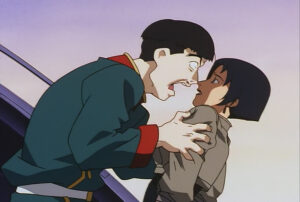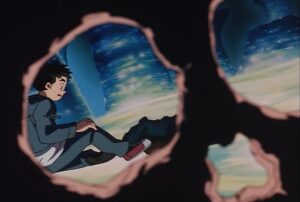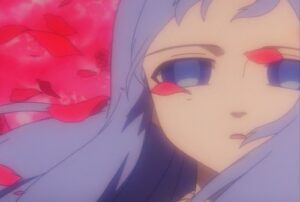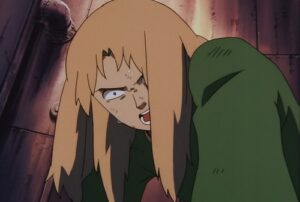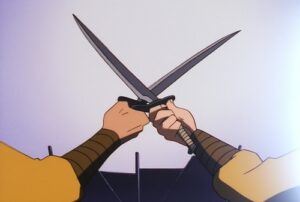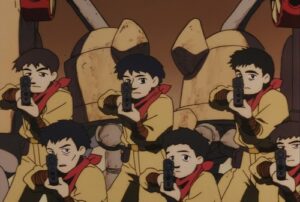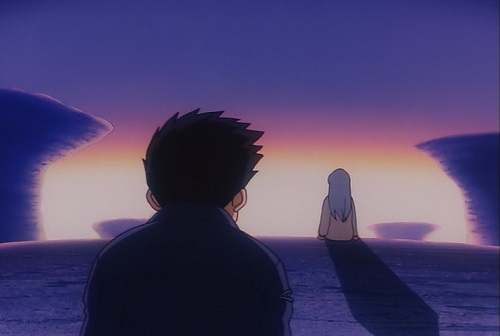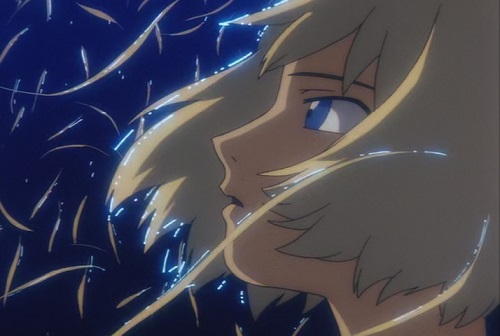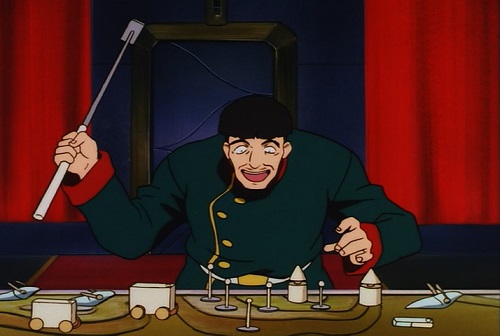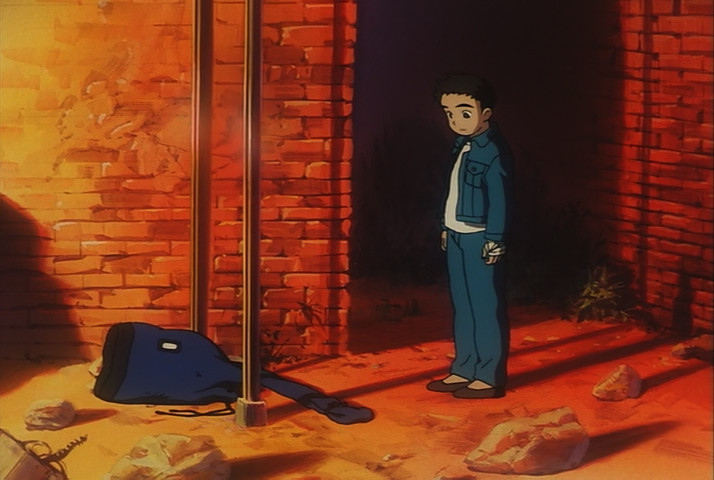There are few anime that I’d describe as profoundly “uncomfortable”. I’m not talking about rampant pedophilia or the questionable relationship with the word “consent” in some series. I just ignore those. What I mean are works that, through their themes and stories, really make you understand what it means to live through these events. I’m talking about works like Serial Experiments Lain and its exploration of our relationship with technology. Or Perfect Blue and how it can feel to lose your own identity. And while this series doesn’t quite reach the same heights as those other two, it certainly makes a respectable try. Created and directed by Akitarou Daichi, animated at studio AIC and with music by Taku Iwasaki, I give to you the subject of today’s review, the turn of the millennium dystopian tragedy: Now and Then, Here and There. Without further ado, let’s dive in!
Be warned, this review contains minor unmarked spoilers for Now and Then, Here and There. It also contains major spoilers in some sections, but these will be heavily marked to avoid accidents. Additionally, this series contains depictions of rape and sexual abuse, which I will mention in this review. You have been warned.
Characters
Normally I start these reviews by talking about the art and animation of a series, it’s visual production. That is, after all, the most obvious and easy to see part of an anime. Even from just a PV you can get an idea of if you will like a series or not. However the fact of the matter is that it is the characters, more than anything else, that are the lynchpin of Now and Then, Here and There. To me, Now and Then is a story about war, children, and the myriad of effects war has on said children. Both in the immediate present and in the future, long after the war is over. Because of that I want start by first looking at 3 of our main characters: Shu, Nabuca and Sara. Don’t worry, major spoilers will be marked.
The core of our story revolves around Shu, who, as we find out in the first episode, was transported to this world from our own. Allowing our modern morals and sensibilities to be compared against, and challenged by, those of this dystopia. Shu is very straight forward as a character. His ideals are naïve and lack any sort of nuance or shades of grey. In that sense, Shu acts a lot like your standard Shounen protagonist. He is someone who sticks blindly to his beliefs regardless of how the world challenges him. Because of this he sticks out like a sore thumb. Only in Now and Then, Shu is the one to suffer, and lose, for doing so. It is through Shu’s lens, through his growth and experiences in war, both he and the viewer learn that the world is much more than black and white.
Spoilers regarding the progression of Shu’s character and his beliefs. Non-spoiler summary: I was slightly disappointed by the end.
Sadly however, and we will talk about this more when I get to the narrative portion, I don’t think Now and Then really does much to support him here. As a character, Shu is initially setup to be interesting and engaging. His beliefs are challenged regularly, each time in a new way. Is murder still wrong if its in self defense? What about revenge, hatred, against unprompted and unreasonable acts of aggression wrong? Is it ever right to kill? But by the end of the series, Shu’s beliefs remain the same. They were challenged yes, but his answer is unchanged. Shu is never forced to compromise on his beliefs. I found that, ultimately, Now and Then supports Shu and considers him better, stronger, for coming through the other side firmer than he was before. And I believe that to be a missed opportunity.
Compare that to Nabuca, a character we meet early on in episode 2. It’s clear from the beginning that Nabuca, like Shu, is a victim of this dystopian world. Like Shu, he was taken from his home and forced to fight here. And like Shu, he has only the best of intentions and doesn’t really like any of this. Nabuca wants nothing more than to protect and take care of the other kids. To get them all back home once this is over. But where Shu is ultimately reinforced in his beliefs, Nabuca was forced to bend to survive. To adapt to this land and to discard some of his humanity to protect those he cares about. It is because of this contrast between these two, and other, characters that I find Nabuca far more engaging and interesting than Shu. If only he got more screen time.
This brings me to the last, and my favorite, of the three I wanted to talk about: Sara. Sadly, to talk about Sara in any depth, I need to spoiler this section as I have to mention major plot revelations and even her own stories ending. The short version is that I absolutely love Sara’s story and that, despite some questionable politics we will talk about later, it was one of the most engaging things I’ve watched in a while. Now on with the spoils!
Sara’s story is, without a doubt, the most difficult and uncomfortable to watch. Despite the fact that she is one of the few to survive to the end, her struggle with rape, identity, revenge and her refusal to be broken, are fantastic. There is no question in my mind that she is, emotionally, the strongest character in this story. Which is why what Now and Then does with the consequences of her rape, IE pregnancy, is so disappointing. Now and Then is very much a show about the future that our children will inherit and how they, the children themselves, are our future. So it should come as no surprise that Now and Then takes on a very pro-life message regarding Sara and whether or not she is morally allowed to get an abortion.
Now and Then forces this pro-life messaging on to Sara. It begs her, pleads with her through Shu, to not hold her rape against the child. That the child did nothing to her and that it is only right she carry it to term. And for me that is… There’s a lot of reasons I moved out of Texas, despite still loving the state. It is here that we see the downside to investing so much of your politics into your work. Don’t get me wrong, all media is in some way political, whether the author intends it or not. However there is a difference between presenting an idea, of implying something and asking the viewer to think about it, and shoving a blowhorn in their face. In doing so you greatly increase the risk of alienating viewers who disagree. Which is exactly what Now and Then did here.
All of this is to say that while I really like the cast of Now and Then, Here and There, they each have their own shortcomings. This is by no means restricted to just these three! Hamdo, our villain, is basically the dictionary definition of a megalomaniacal madman, he isn’t terribly complicated. Yet through contrast with characters such as Elamba he starts to become more. The same kind of give and take exists with everyone, Tabool, Sis, Boo, etc. The only real disappointment I have is Abelia, who is so closely tied to Hamdo that she is dragged down and given the space to be fully explored in her own right. Now and Then has a rich, if flawed, cast of characters. And it is on the backs of these characters that the show succeeds as well as it does.
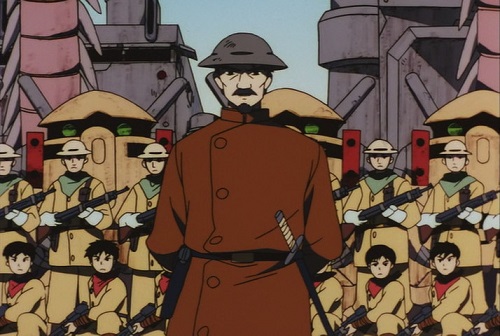
Narrative/Setting
This brings me to the narrative, where I think Now and Then falls a little flat. It’s not that it’s bad, it would take a lot of work to undermine and ruin the characters I’ve already praised. The problem is more that the overarching narrative is simply… serviceable. There are a few missed opportunities here and there, but nothing egregious. It provides a world and an inciting incident with which it kickstarts all of these characters stories. Now and Then thus enables it’s characters to go off and do great things. But I don’t think it does anything to augment them, to make them greater than the sum of their parts. In its journey to tell a character driven morality play, Now and Then neglects the setting and events the characters are supposed to be interacting with. What do I mean? Let me give you an example.
In the very first episode of the show Shu, our protagonist, is brought to this dystopian world by way of some kind of teleporter. Did we cross dimensions, worlds, time, we have no idea and it isn’t made clear until the end of the show. That’s fine. However a problem arises when we look at this devices place in the narrative after this opening. Because, simply put, it doesn’t have one. The device is never mentioned again, never explained, never relevant beyond Shu’s overarching goal of returning home. You would think that such an impressive piece of technology would be at least marginally important to the plot, right? Maybe Hamdo uses it to get supplies, or stage attacks, or whatever. But no. It’s purpose begins, and ends, as a plot device, nothing more. And I’m sad to say that it isn’t the only plot-relevant McGuffin to be used like this.
Of course none of these things are particularly important to the emotional core of Now and Then. The children’s story will be just as effective with or without these McGuffins fitting into the narrative. My praise for the children above, already knowing all of this, is proof enough of that. Indeed, these details only matter if you are trying to piece together and follow the larger narrative of the world and the people within it, which isn’t the focus of Now and Then. But for people who watch these kinds of Sci-Fi dystopian shows for that world building? For the details and intricately crafted universes? I’m afraid that they will find themselves disappointed and that, if not warned ahead of time, it will ruin their experience. Now and Then is a thematic and emotional piece of science fiction. Not a technical, exhaustingly detailed universe piece.
Visuals
Next up I am finally allowed to talk about Now and Then’s production. The narrative may be serviceable, and the characters incredible, but none of that really matters if you can’t stand to look at what you’re watching. So the question is: How does the show look?
Right off the bat I can say that Now and Then is not the most animated of shows, not even from it’s own era. Almost all of the worthwhile cuts you will find occur in either the first or last episode, with most of the stuff between being rather static. However where it lags behind in movement, it more than makes up for it with beautifully picturesque direction. Incredible vistas, well framed set pieces, and memorable stylistic decisions are peppered across Now and Then’s season. I’m talking individual strands of hair shining in the moonlight on a backdrop of deep, dark blue. That same blue giving way to the soft reds and oranges of a sunrise, or viewing an entire scene through the empty sockets of a dried and decrepit skull in the desert. When it wants to, Now and Then looks great. That’s just rarely when it’s actually moving.
I will always find the old cel style of animation appealing. There’s a timeless quality to it that I just don’t think digital animation has. The small mistakes or inconsistencies you can find between cels, the ethereal feel that comes from layering them on top of each other, the lack of ridiculous amounts of post processing, even the old philosophies regarding color design. All of these give cel animation a certain “je ne sais quoi” that I will never tire of. But when I recommend Now and Then, Here and There to you I want to be clear about one thing: Do not watch this show for the visuals. They are fine, it has some great vistas and iconic shots, but it is not a hype set-piece battle sakuga show. It is about quiet moments, staggering loss and reflection with a few bits of action placed to keep our attention.
OST/Sound Design
Finally I come to the music and sound design, the last “real” section of this review. What does that mean? Read on and find out.
Considering the staff on Now and Then, I was expecting the music to be a lot more affecting and memorable than it is. Composed by Taku Iwasaki, the man behind the music of Rurouni Kenshin: Trust and Betrayal as well as Gurren Lagann and Soul Eater, I was hoping for something emotional and resonant. Something to compete with “In Memories (Ko-To-Wa-Ri)“. But I just didn’t get that here. I can find hints of it, I can clearly discern his sound in the strings and flutes of “Miss…” or the slowly building escalation of “Rescuer“. And it’s not like Now and Then doesn’t have impressive pieces of it’s own like the heroic and adventurous “Run Up” or the sheer 20 minute epic that is “Standing in the Sunset Glow” that tells the entire story in one song. It’s just that… None of them evoke scenes or memories to me.
What does that mean, why would memories be important for music? Well for me, the point of an OST is to augment what it is playing over. An OST isn’t meant to stand alone like a new album, it irrevocably ties itself to the story and characters of the show. That’s why I can’t help but think of Kenshin’s walk through the snow covered mountains when I hear “In Memories (Ko-To-Wa-Ri)”. Or why “Libera Me From Hell” from Gurren Lagann makes me think of Kittan. I haven’t watch either of these series in years. Yet these scenes, these emotions, feel clear as the day I watched them just by listening to their music. And that’s nothing something I get from Now and Then. Instead what I get is a reasonable OST that’s half industrial chase music and half somber atmosphere. And while that’s fine… It’s also disappointing.
Luckily the sound design on Now and Then is much better. Though with Kazuya Tanaka on as the Sound Director that shouldn’t come as much surprise. This guy was responsible for the entirety of the Mushi-shi series, which lived and died by it’s sound design. The same holds true here. Tanaka does a great job of realizing the mechanical and desolate nature of this world, changing the sounds as we change location and really immersing you in what’s happening. From rushing water to the stillness as a gun fires, he knows exactly how to use quiet where many others would fill every waking moment with anything to keep your attention. To be honest, I think he does more for some of these scenes than the music does. And that’s pretty damn incredible if you ask me.
So yeah, all in all the music is just alright while everything else sounds great. So… what is there left to talk about?
Politics? In MY Anime?!
With that we come to the personal section of the review. This is where I drop any pretense of trying to rate a show, whether or not I should recommend it to you, or all those other things reviews are supposed to do. Here I’m just going to talk about a small part of my experience with Now and Then in the hopes that it will help you understand my experience with the show. If that doesn’t interest you? Then feel free to skip! I won’t mention staff or anything here, and there will 100% be huge spoilers within. If you are curious about my unfiltered feelings about the show though? Then read on.
So… Politics. Touchy subject right? A lot of people like to avoid it. Going so far as to get upset anytime they perceive politics as intruding upon their entertainment. You see it every time someone complains about “woke” culture in media, or vice versa. But the simple fact is this: The politics were always there, whether you realized it or not. An author will, inevitably, put some of themselves and their beliefs in the stories they write. Whether it be Tolkien’s criticism of technology and industrialism in Lord of the Rings or the rampant racism in H.P. Lovecraft’s entire bibliography. The only question is how overt and obvious the author makes it. Some do it accidentally, not meaning to be political but their opinions naturally appear in their work. Others however write with the express purpose of communicating with, or perhaps convincing, their audience. And this second one has… drawbacks.
That drawback of course being that, with your politics so overtly presented, if your audience disagrees with or finds them distasteful, then you have already alienated a large portion of them right off the bat. Now ultimately I think that’s fine, not all media has to be for everyone. No amount of essays or long walks on the beach will make me like Penguindrum for instance. Nor am I here to tell you that you have to like Now and Then. It’s certainly going to be divisive. But what I can say is that these overt politics make it very awkward to recommend to people. Because unless I know how you feel about certain topics, I cannot say with certainty that you will enjoy Now and Then. Even if I know your taste in anime at large.
Lets take myself as an example: For me, Now and Then, Here and There rides a line. I was profoundly uncomfortable multiple times while watching this show. Some of those were because of its straightforward and rightfully horrifying depictions of rape and child soldiers. And that’s good, those should be uncomfortable subjects when depicted with respect and it made me think about them! But many others were because I simply disagree with it’s politics and message.
I am of course talking about Sara Ringwalt. My previously named favorite character in the show. About 2/3rds of the way through we, and Sara/Shu, learn that Sara is pregnant with the child of her rapists. Touchy subject! However what makes it so uncomfortable is that Now and Then takes the position that Sara should not hold the acts of her abusers against the child. The child… of her abusers. Basically, Now and Then takes a Pro-Life position that abortion is bad even under the worst of circumstances and that the child deserves to live, even in a dystopia. And while I can respect how this fits in with the rest of Now and Then’s themes, as someone who is staunchly Pro-Choice this really put me off.
I want to be clear, I’m not telling you how to think. I especially don’t want to have that argument with random people on the internet when talking about a damn anime review. All I want is to make it clear to you, the reader, that Now and Then, Here and There contains many touchy subjects and it is not afraid to make its opinion on them known. Whether it agrees with you or not, if you are neither prepared nor enjoy engaging with media in that way, then this is not a series for you. Personally? As much as I enjoyed the story, I probably won’t watch it again. Not because it’s dense like Serial Experiments Lain, another show I enjoyed but won’t rewatch, but because I find it’s 2nd half uncomfortable and without enough payoff to make that worth it for me.
Conclusion
So yeah, all in all, would I recommend Now and Then, Here and There to you. I would say… tentatively yes. If you enjoy character driven sci-fi dystopia’s or politically charged think pieces and don’t mind being confronted, strongly, by other people’s politics then I think there is a lot to get out of it. However if you just want a fun sci-fi dystopia to romp around in and be entertained by for 13 episodes? Then I cannot steer you away any harder. You will not have a good experience with this show. Personally though? I’m down for an occasional work like this. Something to break up all my fun Shounen, hype Sports and more serious Iyashikei. I had a good experience with Now and Then, Here and There. Even if it wasn’t necessarily a pleasant one.
And that’s a wrap! Thank you for keeping up with another season of Throwback Thursday. This one was… heavy. Though from the looks of things I may not be free yet. Because the winner of the poll, and my next Throwback Thursday show is… Animated at Studio Gonzo, Created by Tatsuhiko Takimoto and Directed by Directed by Yuusuke Yamamoto I give to you Welcome to the NHK! This is another show I have absolutely no idea what it is about. I’ve heard people talk about it a lot but it isn’t something I’ve ever checked out myself. I know its about a hikikomori and conspiracy theories? Sort of? Whatever the case, I will be starting this series next week on the 26th! Since it’s 2 cour we will be watching 2 episodes a week, so strap in. Looking forward to seeing you all there! Until next time.
Also heads up: I have to travel for work the week of June 13th, so there is a distinct chance I won’t be able to get a post up. I’ll try my best but you never know with travel. On top of that I’ve always been accepted to my graduate school so I might start missing deadlines a bit more.

